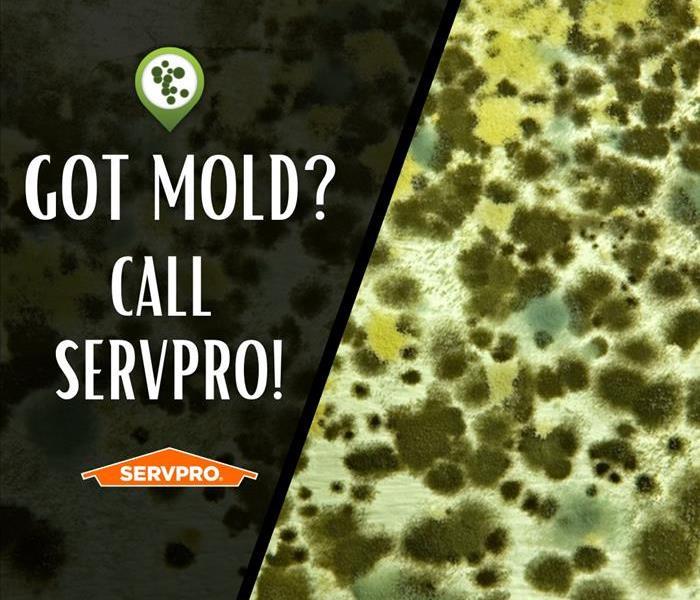Understanding the Diverse Causes of Mold Formation | SERVPRO of Carbondale/Marion
2/29/2024 (Permalink)
Mold is a common and potentially problematic issue that can affect homes and buildings. Its presence not only poses risks to the structure but can also have adverse effects on the health of those living or working within the space. To effectively combat mold, it is crucial to understand the various ways it can form in different environments.
1. Excess Moisture
Mold thrives in damp and humid conditions, making excess moisture the primary factor in mold formation. Several scenarios contribute to elevated humidity levels:
a. Leaky Roofs and Windows:
- Leaks in roofs or around windows allow water to seep into the structure, creating an ideal environment for mold growth.
b. Poor Ventilation:
- Inadequate ventilation can lead to stagnant air, allowing moisture to accumulate and mold to develop.
c. Plumbing Issues:
- Leaky pipes, whether hidden or visible, can introduce water into walls, floors, and ceilings, providing a breeding ground for mold.
d. Basement Dampness:
- Basements are prone to dampness, especially if they are not properly waterproofed. This can lead to mold formation on walls and floors.
2. Floods and Water Damage
Homes and buildings that have experienced flooding or significant water damage are at an increased risk of mold formation. The prolonged presence of moisture following a flood creates conditions conducive to mold growth. Quick and thorough drying is essential in such situations.
3. Condensation
Condensation occurs when warm, moist air comes into contact with a cold surface, leading to the formation of water droplets. Areas prone to condensation include:
a. Windows:
- Condensation on windows can create an environment where mold can thrive on window sills and frames.
b. Cold Walls:
- Exterior walls that are not properly insulated can attract condensation, fostering mold growth.
c. Cold Water Pipes:
- Pipes carrying cold water can accumulate condensation, potentially leading to hidden mold growth.
4. High Humidity
Regions with naturally high humidity levels are more susceptible to mold problems. Coastal areas or places with tropical climates often face challenges in maintaining low humidity, making them prone to mold-related issues.
5. Improperly Sealed Buildings
Buildings that are not properly sealed are more susceptible to external moisture infiltration. This can happen through gaps in walls, roofs, or windows, providing an entry point for water and creating an environment conducive to mold formation.
6. Damp Construction Materials
During construction or remodeling, if building materials are exposed to rain or high humidity and are not adequately dried before installation, they can harbor mold. This hidden mold can later become a problem as the building ages.
7. Airborne Mold Spores
Mold spores are naturally present in the air both indoors and outdoors. While they are usually harmless in low concentrations, when provided with the right conditions, these spores can settle and multiply, leading to mold infestation.
8. Household Activities
Certain household activities can inadvertently contribute to mold growth:
a. Drying Clothes Indoors:
- Hanging wet clothes to dry indoors can introduce excess moisture into the air.
b. Cooking without Proper Ventilation:
- Cooking, especially boiling or frying, releases moisture into the air. Without proper ventilation, this can lead to mold problems.
c. Indoor Plants:
- Overwatering indoor plants can increase humidity levels, creating an environment favorable to mold.
Preventing and Addressing Mold Issues:
Understanding the various causes of mold formation is crucial, but so is taking preventive measures and addressing existing problems promptly. Here are some preventive steps and solutions:
a. Maintain Proper Ventilation:
- Ensure that your home or building is adequately ventilated to prevent the accumulation of stagnant air and moisture.
b. Address Leaks Promptly:
- Repair any leaks in the roof, windows, or plumbing as soon as they are identified.
c. Use Dehumidifiers:
- Employ dehumidifiers in areas prone to high humidity, such as basements or bathrooms.
d. Improve Insulation:
- Properly insulate walls and windows to reduce the likelihood of condensation.
e. Regular Maintenance:
- Conduct regular inspections of the building, checking for leaks, and ensuring proper drainage.
f. Promptly Address Water Damage:
- If your home has experienced flooding or water damage, take immediate steps to dry and sanitize the affected areas.
g. Control Indoor Humidity:
- Maintain indoor humidity levels between 30-50% to discourage mold growth.
h. Properly Seal Buildings:
- Ensure that the building is properly sealed to prevent water infiltration.
i. Use Mold-Resistant Products:
- Consider using mold-resistant building materials, especially in areas prone to dampness.
j. Professional Mold Remediation:
- If mold is already present, consult with professional mold remediation services like SERVPRO of Carbondale/Marion for safe and effective removal.
Conclusion: Vigilance and Proactivity are Key
Mold formation can result from a combination of factors, making it essential to remain vigilant and proactive in preventing and addressing potential issues. By understanding the diverse causes of mold growth, individuals can take steps to create an environment that is inhospitable to mold, ensuring the health and longevity of their homes and buildings. If mold damage becomes an issue, don’t hesitate to call the remediation professionals at SERVPRO of Carbondale/Marion.





 24/7 Emergency Service
24/7 Emergency Service
